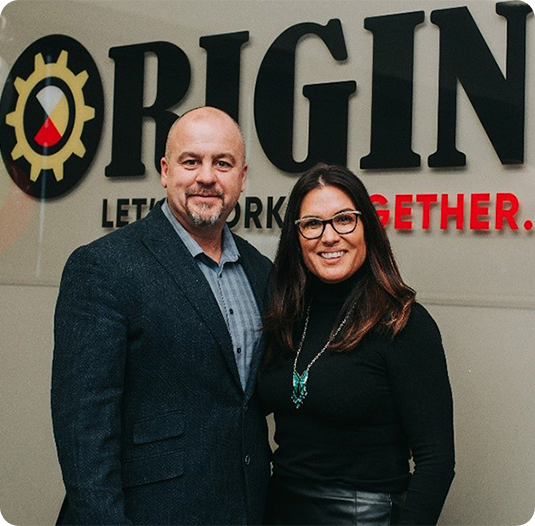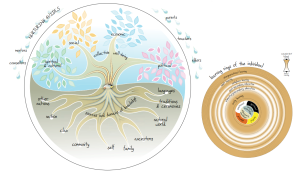Announcements
For press opportunities, please email info@immersivelink.ca.

Integrating Indigenous Culture into Education
Decolonizing the classroom and moving towards reconciliation
September 30th, better known, as Orange Shirt Day, signifies a time to reflect on the dark history of Residential Schools in Canada.
It is important that our non-Indigenous neighbors take the time to sit, discuss and sincerely educate themselves on real truths. Stories you hear may be shocking. Understand the impact of these painful processes directly affected the lives of Indigenous peoples and continue to do so today.
During this month, there will be mentions of educating oneself on this history. I’d like to take it a step further today and talk about the greater impact we see on how educational systems have formed and how the impacts of the residential school system can still be seen today.
History of Education in Canada
In Canada, the origins of our current educational system were heavily influenced by the impacts of colonization and residential schools. Indigenous teachings, culture, history, and languages were not only excluded but erased from curriculum all together. This erasure left a lasting impact on today’s educational system and the Indigenous population.
Residential Schools
At this time, education was a form of control over the population. Ran by the churches and government, they used these institutions to instruct and control the ways of Indigenous peoples, starting with the children. Children were taken to these schools and contact with their families ceased. From arrival, they were forced to adjust even the clothes they wore and how their hair was cut and given English names. And that barely scratches the surface.
Education today
Today, education is viewed as a tool to teach critical thinking and application skills that allow people to form opinions, learn new skills, and understand a variety of topics. While there have been changes in the goals of educational institutions, the curriculum is still centered around Western ideologies.
With these colonial values underpinning educational systems, there is a lack of representation that is needed for Indigenous students across the country.
Significance of Culturally Informed Education
You may be asking yourself, “what is the importance of Indigenous culture in the classroom?” or “what would the impact be?”. The answer is in the numbers.
There have been numerous reports done on the engagement of Indigenous and Non-Indigenous students from primary to post-secondary showing Indigenous students completing their education at a lower percentage than their non-Indigenous peers. Uninformed curriculum, funding, access, and more all contribute to this. Let’s take a deeper look at curriculum.
Indigenous Perspectives on Learning
If you’re reading this, I can assume you have experienced some portion of the Canadian education system and understand how it is structured. While Western education is structured around formal institutions, Indigenous people see education as a lifelong journey taught through generational teachings and is made up of many different elements.

Source: https://firstnationspedagogy.com/CCL_Learning_Model_FN.pdf
The medicine wheel and it’s quadrants represent many different things including states of being and life stages. When we look at life stages there are birth, youth, Elders, and death.
Between these stages there is a lot of intergenerational learning that happens. Elders are looked up to in their communities as Knowledge Keepers who share their stories and skills with younger generations to come. This is important for the youth and their education but also for cultural preservation.
This holistic approach to learning is all about sustainability and cycles. It focuses on the interconnectedness of all elements.
The model above shows the connections between the Western systems and Indigenous learners!
Truth and Reconciliation Calls to Action
I want to mention this piece as I understand that while teachers and educators may be on the ground working with students, they are not in total control of educational policies. There are changes that will need to continue to be made from higher levels of government in education to instill policies that reinforce the commitment to culturally informed curriculum.
When we look at the TRC Calls to Action, we can see that reconciliation and education covers many different areas. It’s about access, preservation, respect, and autonomy.
Including Indigenous culture in the classroom isn’t just about having it taught as part of the course curriculum, it’s about incorporating Indigenous perspectives and practices and teaching methods into the classroom.
Now what does this look like in application?
There really isn’t one simple answer to this question. For different grade levels and different classroom settings there are different approaches to achieving this goal. To generalize, there are a few key areas of focus that are important:
1) Culture in the Curriculum
This one may be the most obvious of all, but actually including classroom content focused on educating about Indigenous culture is important. There are so many areas to be covered from history, traditions, values, languages, traditional garments, ceremonies and more!
2) Culturally informed educators
Having teachers that recognize dates of significance, sensitive topics, and other cultural practices will assist them in best supporting their Indigenous students and allowing them to feel supported in the classroom.
3) Instructional methods
In Indigenous culture, traditions are taught through storytelling and hands-on learning. If there are ways to incorporate hands-on teaching (especially outdoors), this will be a positive way to engage your students in a way that really speaks to them.
Now, these suggestions are really just starting points for making a big change!
Indigenous Values
I previously mentioned the importance and difference in cultural values also being reflected in the educational makeup.
What are core Indigenous values? The Seven Sacred Teachings are the foundational values of Indigenous people. They represent what it means to walk the good path. These values are humility, love, trust, respect, courage, honesty, and wisdom. The origin of these teachings is hundreds of years in the past but they are relevant today. They have applications in our classrooms, workplaces, and lives.
To share these teachings and their modern-day applications, our team has developed ImmersiveLink7. A virtual reality experience that allows users to explore each teaching. They will learn their related animal, breakdown the language, and understand real life applications. This tool is a great way for teachers and students to learn more about Indigenous culture. The implications of these values are relevant to Indigenous and non-Indigenous people alike.
Closing thoughts
As this month comes to as close, I encourage everyone to take the time to learn more about the history of Residential Schools in Canada. Therefore, it’s important to understand how this continues to impact Indigenous people today and will allow those who can make a real difference moving forward.
Today, let’s remember the children who cannot be with us, the survivors, their families, and communities. Every Child Matters!
….
References:
